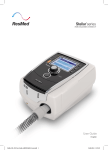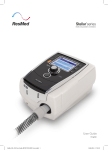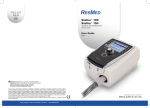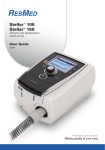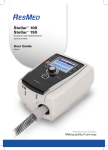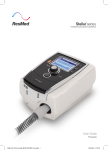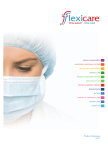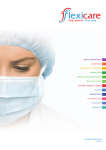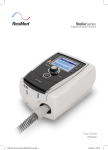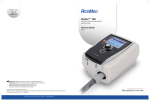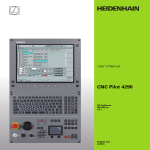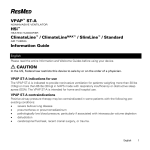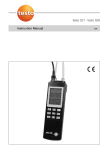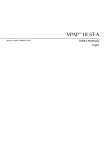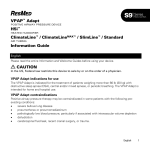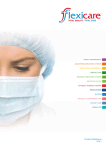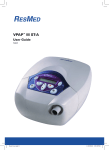Download User Guide - Medical Dynamics, Inc.
Transcript
Your local representative: 866-624-3952 www.thinkMDI.net Stellar™ 100 Invasive and noninvasive ventilator User Guide English Stellar™ 100 User Guide English Contents Introduction . . . . . . . . . . . . . . . . . . . . . . . . . . . . . . . . . . . . . . . . . . . . . . . . 1 Indications for use Contraindications Adverse effects 1 1 1 The Stellar 100 system . . . . . . . . . . . . . . . . . . . . . . . . . . . . . . . . . . . . . . . 2 Setting up the device . . . . . . . . . . . . . . . . . . . . . . . . . . . . . . . . . . . . . . . . 3 Setting up the device for non-invasive use Attaching the H4i heated humidifier for non-invasive use Setting up the device for invasive use Attaching the pulse oximeter Adding supplemental oxygen Attaching antibacterial filters Using the device when mobile Using an external power supply unit 3 3 4 4 5 5 5 6 Using the Stellar 100 . . . . . . . . . . . . . . . . . . . . . . . . . . . . . . . . . . . . . . . . 6 Control panel LCD screen Operating functions Functional test Starting therapy Therapy settings Using mask-fit Stopping therapy Using the internal battery Use of the ResMed USB stick Turning off the device Optional device settings 6 6 7 8 9 9 10 10 10 10 11 11 Alarms . . . . . . . . . . . . . . . . . . . . . . . . . . . . . . . . . . . . . . . . . . . . . . . . . . . . 12 Alarm display Muting alarms Setting the alarm volume Testing the alarm 12 13 13 13 Cleaning and maintenance . . . . . . . . . . . . . . . . . . . . . . . . . . . . . . . . . . 13 Daily Weekly Monthly Replacing the air filter Disinfection Internal battery Maintenance reminder Servicing 13 13 14 14 14 14 14 14 Troubleshooting . . . . . . . . . . . . . . . . . . . . . . . . . . . . . . . . . . . . . . . . . . . 15 Technical specifications . . . . . . . . . . . . . . . . . . . . . . . . . . . . . . . . . . . . . 19 Guidance and manufacturer’s declaration – electromagnetic emissions and immunity Symbols 20 22 General warnings and cautions . . . . . . . . . . . . . . . . . . . . . . . . . . . . . . 22 Limited warranty . . . . . . . . . . . . . . . . . . . . . . . . . . . . . . . . . . . . . . . . . . . 24 Introduction The Stellar 100 is intended to provide ventilation for non-dependent, spontaneously breathing adult and pediatric patients (13kg and above) with respiratory insufficiency, or respiratory failure, with or without obstructive sleep apnoea. The device is for non-invasive use, or invasive use with an uncuffed or deflated tracheostomy. Users of the device include patients and their caregivers, physicians, nurses, respiratory therapists and other clinical staff. Operation of the device includes both stationary, such as in hospital or home, or mobile, such as wheelchair usage. English Indications for use Contraindications The Stellar 100 is contraindicated in patients who are unable to endure more than brief interruptions in ventilation. The Stellar 100 is not a life support ventilator. If you have any of the following conditions, tell your doctor before using this device: • pneumothorax or pneumomediastinum • pathologically low blood pressure, particularly if associated with intravascular volume depletion • cerebrospinal fluid leak, recent cranial surgery or trauma • severe bullous lung disease • dehydration. Adverse effects You should report unusual chest pain, severe headache or increased breathlessness to your prescribing physician. The following side effects may arise during the course of non-invasive ventilation with the device: • drying of the nose, mouth or throat • nosebleed • bloating • ear or sinus discomfort • eye irritation • skin rashes. Introduction 1 The Stellar 100 system Handle Oxygen inlet LCD screen Control panel Air outlet Infrared connection for humidifier AC connection for H4i humidifier Air filter cover Oximetry connection Oxygen sensor connection Data communication ports DC power socket AC power socket Power-on/stand-by switch The Stellar 100 comprises the following elements: • Stellar 100 device • Hypoallergenic air filter • AC power cord • Carry bag • 2 m air tubing • ResMed USB stick • Low pressure oxygen connector. The following optional accessories have been validated for use with the Stellar 100: • 3 m air tubing • SlimLine™ air tubing • Clear air tubing • H4i heated humidifier • Antibacterial filter • ResMed XPOD oximeter • Nonin™ pulse oximetry sensors • Mobility bag • ResMed leak port • Tubing wrap • Heat moisture exchanger filter. WARNING The Stellar 100 should be used with air tubing and accessories recommended by ResMed. Connection of other air tubing or accessories could result in injury or damage to the device. ResMed regularly releases new products. Please check the catalogue of ventilation accessories on our website at www.resmed.com. 2 Setting up the device English Setting up the device for non-invasive use 2 1 3 AC locking clip 4 AC power cord Note: For stationary use, place the device on a flat surface near the head of your bed. WARNING • • • • The air filter cover protects the device in the event of accidental liquid spillage onto the device. Ensure that the air filter and air filter cover are fitted at all times. Make sure that all the air inlets at the rear of the device and under the device and vents at the masks or at the leak port are unobstructed. If you put the device on the floor, make sure the area is free from dust and clear of bedding, clothes or other objects that could block the air inlets. Use only ResMed air tubing with this device. Different types of air tubing may alter the pressure you receive and reduce the effectiveness of your treatment. Do not use conductive or antistatic hoses or tubes. Do not leave long lengths of the air tubing or the cable for the finger pulse sensor around the top of your bed. It could twist around your head or neck while you are sleeping. CAUTION • Be careful not to place the device where it can be bumped or where someone is likely to trip over the power cord. • Make sure the area around the device is dry and clean. Note: ResMed recommends using the AC power cord supplied with the unit. If a replacement power cord is required, contact your ResMed service centre. Attaching the H4i heated humidifier for non-invasive use The H4i heated humidifier attaches to the front of the Stellar 100 to provide heated humidification. The device automatically detects the presence of the humidifier. A humidifier is recommended at all times when stationary (except when mobile), especially for patients experiencing dryness of the nose, throat or mouth. For information on using the H4i, see your humidifier user guide. WARNING • • • Always place the H4i on a level surface below the level of the user to prevent the mask and tubing from filling with water. Make sure that the water chamber is empty and thoroughly dried before transporting the humidifier. The H4i heated humidifier is not intended for mobile use. Setting up the device 3 Notes: • Effective humidification can be achieved up to 25 cm H2O. • The H4i is disabled when the device is not AC powered. • A tubing wrap can help if high humidification is causing water condensation within the tube. Setting up the device for invasive use 2 ResMed leak port Antibacterial filter External humidifier* 1 HMEF* Catheter mount Air tubing 3 4 5 AC locking clip AC power cord 6 7 8 When using this setup, select the mask type “Trach” in the Advanced settings of the Clinical settings menu. * A heat moisture exchange filter (HMEF) can be connected in place of an external humidifier. ResMed recommends using a circuit system with an impedance of maximum 2 cm H2O at 30 L/min, 5 cm H2O at 60 L/min and 16 cm H2O at 120 L/min. WARNING • • The HMEF has to be replaced regularly as specified in the manufacturer’s instructions of use. The H4i is contraindicated for invasive use. An external humidifier approved for invasive use is recommended according to EN ISO 8185. Attaching the pulse oximeter 1 2 Use of a pulse oximeter may be recommended by your clinician. Contraindication The pulse oximeter does not meet defibrillation-proof requirement per IEC 60601-1: 1990, clause 17.h. 4 Adding supplemental oxygen 2 Oxygen supply 1 English Note: Up to 30 L/min at maximum oxygen pressure of 50 mbar can be added. Press spring to release connection after use Attach oxygen only to the specified oxygen connection of the device. WARNING • • • • Use only certified, clean oxygen sources. Oxygen flow must be turned off when the device is not operating, so that unused oxygen does not accumulate within the device and create a risk of fire. Oxygen supports combustion. Oxygen must not be used while smoking or in the presence of an open flame. Only use oxygen supply in well-ventilated rooms. The patient circuit and the oxygen source must be kept at a minimum distance of 2 m away from any sources of ignition (eg, electrical devices). Attaching antibacterial filters 1 2 The use of an antibacterial filter may be recommended by your clinician. Antibacterial filters can be purchased separately from ResMed. Regularly check the filter for entry of moisture or other contaminants. The filter must be changed according to the manufacturer’s specifications. Always perform the Learn circuit function when changing filter types (see “Optional device settings” on page 11). CAUTION Do not use the antibacterial filter with the H4i heated humidifier. Using the device when mobile The mobility bag is intended for mobile use of the Stellar 100. It protects the device against dust and water. For longer mobile use, power the device using the ResMed Power Station II Setting up the device 5 external power supply unit or other DC power supply that meets the required voltage and current specifications. For setup and correct use please read the User Guide of the mobility bag. Using an external power supply unit You can operate the Stellar 100 with the ResMed Power Station II. The ResMed Power Station II is an external lithium ion battery that allows operation of the Stellar 100 where mains power is not available, and can also provide a power back-up in case of an unexpected disruption of the mains supply. For setup and correct use please read the ResMed Power Station II User Guide. Using the Stellar 100 Control panel Mains power External power supply Internal battery Monitoring menu Setup menu Alarm Alarm mute button Info menu LCD screen Push dial (rotate/click) Therapy LED Start/stop button LEDs Therapy LED blue—on during treatment and flashes during mask fitting operation. The therapy LED can be disabled by the clinician. Alarm LED red/yellow—on during an alarm condition or during alarm testing. Power supply LEDs green—on when operating correctly. Internal Battery—when the internal battery is in use, the yellow light/LED is on. The LED flashes when the device is turned off and the battery is charging. Alarm mute LED yellow—on when the alarm mute button is pressed. LCD screen The LCD screen displays the menus, monitoring screens and alarm status. To assist you in adjusting the device, the keypad and LCD are equipped with a backlight. The LCD backlight indicates when the device is turned on, when you press a key or an alarm occurs. The LCD backlight may be set to be on continually (see “Optional device settings” on page 11). If the backlight is set to Auto and no actions are performed for five minutes, the backlight dims. 6 Warm-up feature H4i Therapy mode DC voltage* Patient mode Clinical mode Internal battery Title bar or English Ramp time Program ResMed USB stick Mains power Current screen/number of screens within the menu Settings Scroll bar Therapy status bar *Only available when an external power supply unit is connected. Operating functions Key Function Start/Stop • Starts or stops treatment. • Extended hold for at least three seconds starts the maskfitting feature. Alarm mute • During therapy: Press once to mute an alarm. Press a second time to un-mute an alarm. If the problem is still present, the alarm will sound again after two minutes. See “Muting alarms” on page 13. • In stand-by mode: Extended hold for at least three seconds starts the alarm LED and alarm buzzer test. Menu keys Press the appropriate menu button (monitoring, setup, info) to enter and scroll through the relevant menu. The Monitoring menu comprises the following screens: treatment, monitoring of treatment settings, pressure/flow, minute ventilation/target alveolar ventilation, leak, tidal volume, synchronisation, oximetry (optional). On the Treatment screen you have several settings (see “Therapy settings” on page 9). In the Setup menu you will find the therapy and alarm settings of the Stellar 100. In the options sub menu you can change device settings (see “Optional device settings” on page 11). The Info menu allows you to view the following screens: Therapy statistics, used hours, events during device operation, reminder and device information. Using the Stellar 100 7 Key Function Push dial The Push dial acts as an enter/select button. Change between settings: Rotate the Push dial. The selected button is marked dark blue. Enabling a setting for change: Press the Push dial. The setting will be marked in orange. Change a setting: Rotate the Push dial to change the setting value. Confirm setting change: Press the Push dial within three seconds or setting change times out. Functional test Make sure your device is functioning properly each time before starting therapy. 1 Check that the device is turned off. 2 Check condition of device and accessories. Inspect the device and all the provided accessories (eg, air tubing, mask, humidifier, antibacterial filter, oximetry, oxygen supply, ResMed leak port, catheter mount). If there are any visible defects, the system should not be used. 3 Check the patient circuit setup. Check the integrity of your patient circuit (device and provided accessories) according to the setup descriptions in this User Guide and that all connections are secure. 4 Turn on the device and test alarms. Press the power switch at the back of the device once to turn on the device. Check that the alarm sounds a test beep and the LEDs for the alarm signal and the alarm mute button flash. The device is ready for use when the treatment screen is displayed. If the display shows the Reminder page, follow the instructions, then press the Monitoring menu button to display the Treatment screen. 5 Check batteries. Disconnect the device from the mains and external battery (if in use) so that the device is powered by the internal battery. Check that the Battery use alarm is displayed and the battery LED is on. Note: If the charge state of the internal battery is too low, or if the battery is empty, an alarm occurs. See the Alarm troubleshooting section for further information. Reconnect the external battery (if in use) and check that the LED for the DC power supply is lit. The External DC power use alarm will be displayed and the alarm LED will light. Reconnect the device to the mains. 6 Check humidifier (if in use). Check that the warm-up feature is displayed in the Treatment screen. Start the warm-up feature. Check that the humidifier warm-up symbol is displayed on top of the screen. 7 Check oximeter (if in use). Attach the accessories according to the setup descriptions (see “Attaching the pulse oximeter” on page 4) and go to the Monitoring page in the Monitoring menu. Check that the values for SpO2 and Heart rate are displayed. 8 Check oxygen connection (if in use). If any problems occur, please read the troubleshooting section in this User Guide. Please also check other provided User Instructions of your accessories for troubleshooting information. 8 1 Turn on your device. 2 Fit your patient interface (mask or catheter mount) as described in the user instructions. 3 Lie down and arrange the air tubing so that it is free to move if you turn in your sleep or arrange the tubing so it is comfortable in your wheelchair. 4 To start treatment, press or if the SmartStart/Stop function is enabled, simply breathe into your patient interface and treatment will begin. English Starting therapy CAUTION The Clinical mode is only for clinicians. If the device is operating in clinical mode press the power switch to re-start the device in patient mode . Note: If the circuit configuration has changed, ensure that the Learn circuit function is performed before fitting your patient interface (see “Optional device settings” on page 11). Therapy settings Setting the mask type For information on using masks, see your mask user guide. For the latest available masks, see www.resmed.com. To set the mask type, go to the Settings menu, Clinical settings, Advanced settings. WARNING Perform the Learn circuit function before the first use and each time any changes are made to the circuit. You must also check the correct setting of the patient interface. Failing to perform these actions may mean that under certain set pressures and combinations of air delivery components that alarms, eg, Leak alarm, fail to activate. Note: When the mask type is set to “Trach” or “Full Face” the Non-vented mask alarm is enabled. Change settings in Treatment screen The treatment screen is displayed when the device is turned on. Depending on your configuration and settings, the functions set ramp, warm up humidifier or set program may be available (explanations see below). To change a setting proceed as follows: 1 2 3 4 From your treatment screen turn till the required setting is displayed in dark blue. Press . The selection is highlighted in orange. Turn until the setting you require is displayed. Press within three seconds to confirm your choice or setting change times out. Ramp time Ramp time is a feature that can be enabled by your clinician by setting a maximum ramp time. Designed to make the beginning of treatment more comfortable, ramp time is the period during which the pressure increases from a low start pressure to the treatment pressure. Program Your clinician can set two programs with the therapy and alarm settings appropriate to your therapy and set the program availability on the treatment screen. Using the humidifier warm-up function The H4i heated humidifier will be automatically detected when the device is turned on. The treatment screen will give you the option to start warming up the humidifier prior to starting treatment. If the humidifier is heating, the related symbol is displayed at the top of the LCD screen. Note: The H4i can only be used when the device is connected to mains supply. Using the Stellar 100 9 Using mask-fit You can use mask-fit to help you fit your mask properly. This feature delivers treatment pressure for a three-minute period, prior to starting treatment, during which you can check and adjust your mask-fit to minimise leaks. 1 Fit your mask as described in the mask user guide. 2 Hold down for at least three seconds until air pressure delivery starts. 3 If necessary, adjust your mask, mask cushion and headgear until you have a good mask fit. You can end mask-fit at any time by pressing . After three minutes, treatment will begin. Notes: • Press for at least three seconds during mask-fit to start the treatment immediately. The treatment screen will be displayed. • The mask-fitting feature is disabled when the mask type “Trach” is selected. Stopping therapy To stop treatment at any time, remove your patient interface and press or if the SmartStart/Stop function is enabled, simply remove your mask. Notes: • The SmartStop function is disabled if the mask type “Full Face”, “Trach” or special alarms have been set by your clinician. The function is also disabled if the mask-fitting feature is running. • When the device is stopped and operating in standby mode with integrated humidifier it will continue to blow air gently to assist cooling of the heater plate. • Masks with high resistance (eg, pediatric masks) may cause the operation of the SmartStop feature to be restricted. Using the internal battery In case of a mains disruption, the device will operate using the internal battery if there is no external battery connected to the device. The internal battery will operate for approximately two hours under normal conditions (see “Technical specifications” on page 19). The power status of the battery is displayed on top of the LCD screen. Check the battery status regularly while operating the device with the internal battery and connect the device in time to mains power or alternatively to the external battery. To recharge the internal battery, connect the Stellar 100 to mains power. It will take approximately three hours to fully recharge the internal battery, however this can vary depending on environmental conditions and if the device is in use. Note: The battery duration depends on the state of charge, the environmental conditions, the Stellar 100 settings and the patient circuit setup. Use of the ResMed USB stick A ResMed USB stick may be used with the Stellar 100 either to help your clinician to monitor your treatment or to provide you with updates to your device settings. You can connect one ResMed USB stick to one of the data communication ports at the rear of the device. The Stellar 100 checks the USB stick and opens a dialogue for the data transfer. The various operations are described in the following table. 10 Function Description Read settings The settings will be transfered from the connected ResMed USB stick to the Stellar 100. Write settings / Write settings and loggings The settings or the settings and loggings of the Stellar 100 will be saved on the connected ResMed USB stick. Description Cancel Data transfer will be cancelled. You can also disconnect the ResMed USB stick to Cancel the action. WARNING Only the ResMed USB stick is designed to be connected to the data communication port. Do not connect any other device to the data communication ports. Connecting other devices could result in injury, or damage to the Stellar 100 (see “General warnings and cautions” on page 22). English Function CAUTION Do not disconnect the ResMed USB stick while data transfer is in progress. Otherwise loss of data or incorrect data may result. The download time depends on the data volume. Note: Unknown files can get lost during data transfer. Turning off the device 1 Turn off the oxygen flow if used. 2 Check that the device is in standby mode (no ventilation). 3 Press the power switch once and follow the instructions on the display. Note: To disconnect the device from the mains power pull out the power cord from the power socket. Optional device settings The optional device settings are available from the Options menu and the Configuration submenu. Function Description Settings Learn Circuit The device is calibrated according to your air tubing system. Before performing the Learn circuit function, set up the circuit including accessories and patient interface (except catheter mount and HMEF for invasive use). The circuit must be unobstructed and left open to the air while performing the Learn circuit function. Notes: • The Learn circuit function has to be performed with every change of the circuit configuration. • Turn off the oxygen flow. The function is enabled by pressing the Push dial. SmartStart/ Stop™ If SmartStart/Stop is enabled by your clinician, the device will start automatically when you start breathing and will stop automatically when you take your mask off.1, 2 ON/OFF Ramp Time Pressure will be slowly increased to full operating pressure during the ramp time. 0 - Max ramp time (max. 45 minutes) Using the Stellar 100 11 Function Description Settings Selects the menu language. Depends on regional configuration Brightness3 Setting of the LCD backlight brightness. 20% - 100 % Backlight3 Enables or disables the LCD backlight. If the AUTO setting is selected the backlight turns off after five minutes without any actions and turns on again if any button is pressed again or an alarm occurs. ON/AUTO Time3 Setting of the time. Hours, minutes, seconds 3 Language 3 Setting of the date. Day, month, year Time format3 Setting of the time format. 24 h/12 h 3 Setting of the date format. dd/mm/yyyy, mm/dd/yyyy Date Date format To return to the Options screen press the Return button 1 2 3 If you select “Full Face” or “Trach” as the mask type, SmartStop is automatically disabled. SmartStop is automatically disabled when the Leak or Low minute ventilation alarm is set to ON because, if either of these conditions occur, SmartStop will stop treatment before the alarm signal is activated. Only displayed on the Configuration menu. Alarms This device is fitted with alarms to alert you to changes that will affect your treatment. WARNING This device is not intended to be used for vital signs monitoring. If vital signs monitoring is required, a dedicated device should be used for this purpose. Alarm display The alarm LED lights during an alarm or the alarm test. Additionally an alarm message is shown on top of the LCD. High priority alarms are displayed in red, medium priority alarms in yellow and low priority alarms in turquoise. For further information about alarms see “Troubleshooting” on page 15. Your clinician has the option to set and to turn on or turn off the alarms. Press the settings menu key and switch to the alarm page to view the current settings. Alarm message Alarm LED Alarm mute key 12 You can mute an alarm by pressing the Alarm Mute key once. When an alarm is muted the LED of the alarm mute key will light constantly. Pressing this key a second time will un-mute the alarm and the LED of the alarm mute key will go out. In case of a high or medium priority alarm the alarm will sound again after two minutes if the problem is still present. The alarm LED will remain on until the problem is solved. The top of the LCD will display the alarm message as long as the problem is present, except if the alarm mute key was pressed when a low priority alarm occured. If a high or medium priority alarm occured and the alarm mute key was pressed, the alarm mute symbol will be displayed on the LCD. When the alarm mute key is pressed during therapy for at least three seconds, specific alarm messages and the audible alarm will be temporarily reset. English Muting alarms Setting the alarm volume To set the alarm volume, select the Settings menu, then Alarm settings. The alarm volume can be set to low, medium or high. After the set value has been confirmed, the alarm will sound and the alarm LED lights. Testing the alarm When the device is turned on, the alarm LED and the alarm mute key LED will flash, and the alarm will beep to confirm that the alarm is working. If required, you can test the alarm manually by holding down the alarm mute button for at least three seconds when therapy is not running. Cleaning and maintenance The cleaning and maintenance described in this section should be carried out regularly. This also helps to prevent the risk of cross contamination. Refer to your mask, humidifier and other accessories user guide for detailed instructions for care and maintenance. WARNING • • Beware of electric shock. Do not immerse the device, pulse oximeter (if used) or power cord in water. Turn off the device, unplug the power cord from the power socket and the device before cleaning and be sure that it is dry before reconnecting. The mask system and air tubing are subject to normal wear and tear. Inspect them regularly for damage. CAUTION The device cannot be sterilised. Daily Disconnect the air tubing from the device (and humidifier, if used) and hang it in a clean, dry place until next use. CAUTION Do not hang the air tubing in direct sunlight as the tubing may harden over time and eventually crack. Weekly 1 2 3 4 Remove the air tubing from the device and the patient interface. Wash the air tubing in warm water using mild detergent. Rinse thoroughly, hang and allow to dry. Reconnect the air tubing to the air outlet and patient interface. CAUTION Do not use bleach, chlorine, alcohol or aromatic-based solutions (including all scented oils), moisturising or antibacterial soaps to clean the air tubing or the device. These solutions may cause hardening and reduce the life of the product. Cleaning and maintenance 13 Monthly 1 Wipe the exterior of the device and the pulse oximeter (if used) with a damp cloth and mild detergent. 2 Check the air filter to check if it is blocked by dirt or contains holes. Replacing the air filter Replace the air filter every six months (or more often if necessary). 1 2 3 4 Remove the air filter cover from the back of the device. Remove and discard the old air filter. Insert a new air filter. Refit the air filter cover. WARNING Do not wash the air filter. The air filter is not washable or reusable. Disinfection Disinfection of your device helps to prevent the risk of cross contamination. Disinfect the exterior of the device, and especially the air outlet, with a damp cloth and a disinfection solution (eg, Microzid). Internal battery The internal battery of your device has to be discharged and recharged every six months. 1 Remove the power cord while the Stellar 100 is providing therapy and let the device operate with the internal battery to a charge level of 50%. 2 Reconnect the power cord to the mains power while the device is operating. The internal battery will be recharged. CAUTION The internal battery must be replaced after two years. Replacement of the internal battery should only be performed by an authorised agent. Under no circumstances should you attempt to replace the internal battery yourself. Maintenance reminder Your device informs you about the following maintenance events that are set by your clinician: Replace mask, call provider, replace filter, service due, custom reminder. If an event occurs, it will be shown on the Reminder screen right after the device is turned on. Once the maintenance issue has been dealt with, you have to confirm this to reset the reminder date. Servicing This product should be inspected by an authorised ResMed service centre five years from the date of manufacture. Prior to this, the device is intended to provide safe and reliable operation provided that it is operated and maintained in accordance with the instructions provided by ResMed. Applicable ResMed warranty details are provided with the device at the time of original supply. Of course, as with all electrical devices, if any irregularity becomes apparent, you should exercise caution and have the device inspected by an authorised ResMed service centre. CAUTION Inspection and repair should only be performed by an authorised agent. Under no circumstances should you attempt to open, service or repair the device yourself. 14 Troubleshooting Problem / possible cause Solution LCD turns off. The device stops delivering air pressure Power failure. LCD: Remove the mask or the catheter mount from the tracheotomy tube until power is restored. English If there is a problem, try the following suggestions. If a problem cannot be solved, contact your equipment supplier or ResMed. Do not attempt to open the device. Internal Battery Empty! (Alarm) The voltage capacity is below 15%.The device is powered by the internal battery for maximum 2 minutes. Connect the device to mains power. Note: In case of a total power failure, the current settings will be stored and restored when the device is powered again. LCD: System Failure! [X] (Alarm) The device could stop delivering air pressure Component failure. LCD: Over Pressure! (Alarm) The device generates a pressure that is too high. Treatment will be stopped. LCD: Check the airpath for any blockages. Remove the blockages. Stop treatment. Re-start treatment. Therapy could be stopped automatically. Ensure the ambient temperature conditions are within the specified operating range. If the problem persists within the specified operating conditions please return the device for servicing. High Pressure! (Alarm) Mask pressure exceeds alarm setting level. LCD: 1. 2. 3. 4. High Temperature! [X] (Alarm) The temperature inside the device is too high. LCD: 1. Turn off the device. 2. Check that the air tubing is connected properly. 3. Turn on the device again. 4. Re-start treatment. Blocked Tube! (Alarm) Airpath is blocked. LCD: 1. Turn off the device. 2. Turn on the device again. 3. Re-start treatment. 1. Stop treatment. 2. Re-start treatment. Low Pressure! (Alarm) • Mask pressure has dropped below the alarm setting level. • Mask is removed while SmartStop has been disabled. 1. Check that the air tubing is connected properly. 2. Stop treatment. 3. Re-start treatment. Troubleshooting 15 Problem / possible cause LCD: Circuit disconnected! (Alarm) The air tubing is not connected properly to the humidifier or the device. LCD: Contact your clinician. High Leak! (Alarm) High mask leak for more than 20 seconds. LCD: Contact your clinician. Low Respiratory Rate!, High Respiratory Rate! (Alarm) The respiratory rate level has dropped below or has exceeded the alarm setting level. LCD: 1. Check that the air tubing is connected properly to the humidifier or the device. 2. Re-start treatment. Low Minute Ventilation! (Alarm) Minute ventilation level has dropped below the alarm setting level. LCD: Solution Adjust the mask to minimise leak (see “Using mask-fit” on page 10). Non-Vented Mask! (Alarm) Note: The non-vented mask alarm activates within 30 seconds of using therapy with a non-vented mask or invasive ventilation without a leak port (for exhalation). • Connection of a non-vented mask. • Mask expiratory flow port (vent) may be blocked. • ResMed leak port is missing or flow ports (vent) are blocked. LCD: Apnoea! (Alarm) The device detects an apnoea. LCD: H4i cannot be used for treatment pressures exceeding 25 cm H2O. Contact your clinician. Keypad Failure! (Alarm) One of the keys was held down for more than 10 seconds or got stuck. 16 Check if the finger sensor or the XPOD is attached properly to the finger and connection to the pulse oximeter respectively the device is proper. Pressure too high for H4i! (Alarm) The device delivers an over pressure with connected H4i humidifier. LCD: Contact your clinician. SpO2 finger sensor failure!, Xpod oximeter disconnected! (Alarm) The finger sensor or the pulse oximeter is not connected properly or delivers faulty values. LCD: Connect the device to mains power. Low SpO2! (Alarm) The oxygen saturation of the blood is too low. LCD: Breathe normally to disable the alarm. Internal Battery Low! (Alarm) The voltage capacity of the internal battery is below 30%. LCD: • Ensure your mask has an expiratory flow port (vent). • Ensure your mask expiratory flow ports (vents) are not blocked. • Ensure the leak port is installed and that the flow ports (vent) are not blocked. • Contact your clinician. 1. Stop treatment. 2. Re-start treatment. Problem / possible cause Attention High Temp! [X] (Alarm) The temperature inside the device is high. LCD: Internal Battery Use! (Alarm) The device is using the internal battery. LCD: Ensure the ambient temperature conditions are within the specified operating range. If the alarm remains enabled stop treatment then re-start treatment. If the problem persists within the specified operating conditions please return the device for servicing. English LCD: Solution Check if the power cord is properly connected to the device and the power socket. External DC Power Use! (Alarm) The device loses (accidental or intentional) mains power and switches to external DC power. Check if the power cord is properly connected to the device. No display Power not connected. Ensure the power cord is connected and press the switch at the back of the device once. Treatment pressure seems low Ramp time is in use. Wait for air pressure to build up. Air filter is dirty. Replace air filter. Air tubing is kinked or punctured. Straighten or replace tubing. Air tubing is not connected properly. Check air tubing connection. Mask and headgear not positioned correctly. Adjust position of mask and headgear. Plug(s) missing from access port(s) on mask. Replace plug(s). Pressure required for treatment may have changed. See your clinician to adjust the pressure. There is a large impedance (eg, antibacterial filter) in the air circuit. Perfom the Learn circuit function. Humidifier control dial set too high, resulting in accumulation of water in the air tubing. Turn humidifier control down and empty the water from the air tubing. The device does not start when you breathe into the patient interface SmartStart/Stop not on. Consult your clinician. Breath is not deep enough to trigger SmartStart. Take a deep breath in and out through the patient interface. There is excessive leak. Adjust position of mask and headgear. Plug(s) may be missing from access port(s) on mask. Replace plug(s). Air tubing is not connected properly. Connect firmly at both ends. Air tubing is kinked or punctured. Straighten or replace. Troubleshooting 17 Problem / possible cause Solution There is a large impedance (eg, antibacterial filter) in the air circuit. Perform the Learn circuit function. The device does not stop when you remove your mask SmartStart/Stop is disabled. Consult your clinician. Use of a full face mask or tracheotomy tube. SmartStop does not work with a full face mask or tracheotomy tube. Incompatible humidifier or mask system being used. Use only equipment as recommended and supplied by ResMed. Leak Alarm or Low Minute Ventilation Alarm is set to ON. Consult your clinician. “Confirm Stop” is enabled. Consult your clinician. Leak Alarm is enabled, but alarm does not activate when the mask is removed during treatment Incompatible air delivery system being used. Use only equipment as recommended and supplied by ResMed. Pressure settings are too low for the air delivery components being used. Perform the Learn circuit function to adjust the mask pressure according to your air tubing system. The delivered airflow is not heated although the H4i humidifier is in use The humidifier is not properly attached. Correctly attach humidifier. The humidifier does not heat. The device is currently powered by battery. The humidifier does not work. Return your device and the humidifier for servicing. Data storage device is not readable or writeable The data storage device contains unreadable data, does not have enough space available or is not compatible with the device. LCD: is displayed on top of the LCD. Battery is not charging. 18 Consult your clinician. Ensure the ambient temperature conditions are within the specified operating range. Turn off the device. Turn on the device again. If the problem persists within the specified operating conditions please return the device for servicing. Operating pressure range • IPAP: 2 cm H2O to 40 cm H2O • EPAP: 2 cm H2O to 25 cm H2O • CPAP: 4 cm H2O to 20 cm H2O Maximum single fault pressure 60 cm H2O Breathing resistance under single fault 2 cm H2O at 30 L/min; Mask pressure tolerance IPAP: ± 0.5 cm H2O ± 10% of set pressure (end of inspiration) EPAP/PEEP: ± 0.5 cm H2O ± 4% of set pressure CPAP: ± 0.5 cm H2O ± 10% of set pressure Mask flow tolerance ± 6 L/min or 20%, whichever is greater English Technical specifications 7.2 cm H2O at 60 L/min Maximum flow > 200 L/min at 20 cm H2O Sound pressure level < 30 dB(A) Dimensions (L x W x H) 230 mm x 170 mm x 120 mm Weight 2.1 kg Air outlet 22 mm taper, compatible with ISO 5356-1:2004 Anaesthetic & Respiratory Equipment - Conical Connectors Pressure measurement Internally mounted pressure transducer Flow measurement Internally mounted flow transducer Power supply AC 100–240V, 50–60Hz, 2.2 A, max. 65 W External DC Power Supply 24 V, 3 A Internal Battery Lithium-Ion battery, 14.4 V, 1.6 Ah, 23 Wh Battery run-time: 2 hours (measured at IPAP15 cm H2O, EPAP 5 cm H2O, nasal mask, 2 m air tubing, no leak, 20 bpm) Housing construction Flame retardant engineering thermoplastic Air filter Electro static fibre mesh with TPE frame structure Environmental conditions • Operating temperature: 0°C to 35°C • Operating humidity: 10%–95% non-condensing • Storage and transport temperature: -20°C to 60°C (+50°C*) • Storage and transport humidity: 10%–95% noncondensing • Air pressure: 1,100hPa to 680hPa; Altitude: 3,500 m *NONIN XPOD Air tubing Flexible plastic, 2 m or 3 m length (22 mm diameter) SlimLine air tubing Flexible plastic, 1.83 m length (15 mm diameter) Electromagnetic compatibility Product complies with all applicable electromagnetic compatibility requirements (EMC) according to IEC60601-1-2, for residential, commercial, and light industry environments. For further details see “Guidance and manufacturer’s declaration – electromagnetic emissions and immunity” on page 20. Technical specifications 19 IEC 60601-1 classifications Class II (double insulation), type BF, continuous operation Aircraft use Product complies with RTCA/DO-160 section 21 requirements. Consult the medical services department of your carrier if you intend to use your device on an aircraft. Note: You should not use the Stellar 100 while the aircraft is taking off or landing. This device is not suitable for use in the presence of a flammable anesthetic mixture with air, or nitrous oxide entrained in the device airpath. Notes: • The manufacturer reserves the right to change these specifications without notice. • Pressure may be displayed in cm H2O or hPa. • Further clinical information is available through your authorised ResMed service centre. Guidance and manufacturer’s declaration – electromagnetic emissions and immunity Medical Electrical Equipment needs special precautions regarding EMC and needs to be installed and put into service according to EMC information provided in this document. Guidance and manufacturer’s declaration – electromagnetic emissions The device is intended for use in the electromagnetic environment specified below. The customer or the user of the device should assure that it is used in such an environment. Emissions test Compliance Electromagnetic environment - guidance RF emissions CISPR11 Group 1 The device uses RF energy only for its internal function. Therefore, its RF emissions are very low and are not likely to cause any interference in nearby electronic equipment. RF emissions CISPR 11 Class B Harmonic Emissions IEC 61000-3-2 Class A The device is suitable for use in all establishments, including domestic establishments and those directly connected to the public low-voltage network that supplies buildings used for domestic purposes. Voltage Fluctuations/Flicker Emissions IEC 61000-3-3 Complies Warnings: The device should not be used adjacent to or stacked with other equipment. If adjacent or stacked use is necessary, the device should be observed to verify normal operation in the configuration in which it will be used. The use of accessories (eg, humidifiers) other than those specified in this manual is not recommended. They may result in increased emissions or decreased immunity of the device. Guidance and manufacturer’s declaration – electromagnetic immunity The device is intended for use in the electromagnetic environment specified below. The customer or the user of the device should assure that it is used in such an environment. IEC60601-1-2 test level Compliance level Electromagnetic environment –guidance Electrostatic discharge (ESD) IEC 61000-4-2 ±6 kV contact ±8 kV air ±6 kV contact ±8 kV air Floors should be wood, concrete or ceramic tile. If floors are covered with synthetic material, the relative humidity should be at least 30%. Electrical fast transient/burst IEC 61000-4-4 ±2 kV for power supply lines ±2 kV Mains power quality should be that of a typical commercial or hospital environment. ±1 kV for input/output lines ±1 kV Surge IEC 61000-4-5 ±1 kV differential mode ±1 kV differential mode ±2 kV common mode ±2 kV common mode Immunity test 20 Mains power quality should be that of a typical commercial or hospital environment. <5% Ut (>95% dip in Ut) for 0.5 cycle < 12 V (>95% dip in 240V) for 0.5 cycle 40% Ut (60% dip in Ut) for 5 cycles 96 V (60% dip in 240 V) for 5 cycles 70% Ut (30% dip in Ut) for 25 cycles 168 V (30% dip in 240 V) for 25 cycles <5% Ut (>95% dip in Ut) for 5 sec <12 V (>95% dip in 240 V) for 5 sec Power frequency (50/60 Hz) magnetic field IEC 61000-4-8 3 A/m 3 A/m Mains power quality should be that of a typical commercial or hospital environment. If the user of the device requires continued operation during power mains interruptions, it is recommended that the device be powered from an uninterruptible power source. English Voltage dips, short interruptions and voltage variations on power supply input lines IEC 61000-4-11 Power frequency magnetic fields should be at levels characteristic of a typical location in a typical commercial or hospital environment. Portable and mobile RF communications equipment should be used no closer to any part of the device, including cables, than the recommended separation distance calculated from the equation applicable to the frequency of the transmitter. Recommended separation distance: Conducted RF IEC 61000-4-6 3 Vrms 150 kHz to 80 MHz 3 Vrms d = 1.17 √P Radiated RF IEC 61000-4-3 10 V/m 80 MHz to 2.5 GHz 3 V/m d = 0.35 √P 80 MHz to 800 MHz d = 0.70 √P 800 MHz to 2.5 GHz where P is the maximum output power rating of the transmitter in watts (W) according to the transmitter manufacturer and d is the recommended separation distance in metres (m). Field strengths from fixed RF transmitters, as determined by an electromagnetic site survey,a should be less than the compliance level in each frequency range.b Interference may occur in the vicinity of equipment marked with the following symbol: NOTE 1: Ut is the AC mains voltage prior to application of the test level. NOTE 2: At 80 MHz and 800 MHz, the higher frequency range applies. NOTE 3: These guidelines may not apply in all situations. Electromagnetic propagation is affected by absorption and reflection from structures, objects and people. a Field strengths from fixed transmitters, such as base stations for radio (cellular/cordless) telephones and land mobile radios, amateur radio, AM and FM radio broadcast and TV broadcast cannot be predicted theoretically with accuracy. To assess the electromagnetic environment due to fixed RF transmitters, an electromagnetic site survey should be considered. If the measured field strength in the location in which the device is used exceeds the applicable RF compliance level above, the device should be observed to verify normal operation. If abnormal performance is observed, additional measures may be necessary, such as reorienting or relocating the device. b Over the frequency range 150 kHz to 80 MHz, field strengths should be less than 10 V/m. Recommended separation distances between portable and mobile RF communications equipment and the device The device is intended for use in an environment in which radiated RF disturbances are controlled. The customer or the user of the device can help prevent electromagnetic interference by maintaining a minimum distance between portable and mobile RF communications equipment (transmitters) and the device as recommended below, according to the maximum output power of the communications equipment. Separation distance according to frequency of transmitter (m) Rated maximum output power of transmitter (W) 150 kHz to 80 MHz d = 1.17 √P 80 MHz to 800 MHz d = 0.35 √P 800 MHz to 2.5 GHz d = 0.7 √P 0.01 0.17 0.04 0.07 0.1 0.37 0.11 0.22 1 1.17 0.35 0.7 Technical specifications 21 10 3.69 1.11 2.21 100 11.70 3.50 7.0 For transmitters rated at a maximum output power not listed above, the recommended separation distance d in metres (m) can be determined using the equation applicable to the frequency of the transmitter, where P is the maximum output power rating of the transmitter in watts (W) according to the transmitter manufacturer. NOTE 1: At 80 MHz and 800 MHz, the separation distance for the higher frequency range applies. NOTE 2: These guidelines may not apply in all situations. Electromagnetic propagation is affected by absorption and reflection from structures, objects and people. Symbols Follow instructions for use; Class II equipment; Type BF equipment; IP31 Device is protected against solid foreign objects of 2.5 mm diameter and greater and vertically falling water drops; equipment; Caution; Standby or preparatory state for a part of Connection for oxygen supply; max 30 l/min (max 30 L/min); communication port; Data CE labeling in accordance with EC directive 93/42/EEC, class II b; + 60 °C + 140 °F - 20 °C - 4 °F Temperature limitation for storage and transport; humidity; Keep dry; Serial number; away from sunlight; Manufacturer; Batch code; Handle with care; Upside; Catalogue number; Do not re-use; Do not use if package is damaged; Maximum Use by date; LATEX Keep Latex-free Environmental information This device must be disposed of in accordance with the laws and regulations of the country in which disposal occurs. The crossed-out wheeled bin symbol indicates that the product bearing this symbol may not be disposed of together with general household waste, but instead requires separate disposal. This requirement for separate disposal is based on the European Directive 2002/96/EC for electrical and electronic equipment, and the European Directive 2006/66/EC for batteries. You can hand in the product at a municipal collection point, for example. This reduces the impact on natural resources and prevents contamination of the environment through the release of hazardous substances. Batteries containing more than 0.0005 percent of mercury by mass, more than 0.002 percent of cadmium by mass or more than 0.004 percent of lead by mass are marked below the crossed-bin symbol with the chemical symbols (Hg, Cd, Pb) of the metals for which the limit is exceeded. For further information regarding product disposal, please contact your local ResMed office or your specialist distributor, or visit our website at www.resmed.com. Dispose of used air filters and air tubings according to the directives in your country. General warnings and cautions WARNINGS A warning alerts you to possible injury. • Read the entire manual before using the device. • This device should only be used with air tubing and accessories recommended by ResMed or the prescribing clinician. Use of incorrect air tubing and accessories may affect the functioning of this device. • The Stellar 100 and the accessories are to be used for the specified intended use only. 22 • • • • • • The Stellar 100 must only be used with masks (and connectors1) recommended by ResMed, or by a clinician or respiratory therapist. A mask should not be used unless the Stellar 100 is turned on and operating properly. The vent hole or holes associated with the mask should never be blocked. Explanation: The Stellar 100 is intended to be used with special masks (or connectors1) which have vent holes to allow continuous flow of air out of the mask. When the device is turned on and functioning properly, new air from the device flushes the exhaled air out through the mask vent holes. However, when the device is not operating, insufficient fresh air will be provided through the mask, and the exhaled air may be rebreathed. Rebreathing of exhaled air for longer than several minutes can, in some circumstances, lead to suffocation. This applies to most Positive Airway Pressure devices. In the event of power failure2 or machine malfunction, no air pressure will be delivered. Remove the mask or the catheter mount from the tracheotomy tube. Explosion hazard – do not use in the vicinity of flammable anesthetics. Only use orignal and approved ResMed accessories and parts. Use only accessories from the original package. If the packaging is damaged, the respective product must not be used, and should be disposed along with the packaging. Before using the Stellar 100 and the accessories, ensure that all components are in a proper condition and that their operational safety is guaranteed. Do not use the system if there are obvious external defects or unexplained changes in performance. Additional equipment connected to medical electrical equipment must comply with the respective IEC or ISO standards (eg, IEC 60950 for data processing equipment). Furthermore all configurations shall comply with the requirements for medical electrical systems (see IEC 60601-1-1 or clause 16 of the 3Ed. of IEC 60601-1, respectively). Anybody connecting additional equipment to medical electrical equipment configures a medical system and is therefore responsible that the system complies with the requirements for medical electrical systems. Attention is drawn to the fact that local laws take priority over the above mentioned requirements. If in doubt, consult your local representative or the technical service department. English • CAUTIONS A caution explains special measures for the safe and effective use of the device. • When using accessories, read the manufacturer’s User Manual. For consumables important information can be provided on the packaging, see also symbols on page 22. • At low pressures, the flow through the exhalation ports of your mask may not clear all exhaled gas from the tubing. Some rebreathing may occur. • The device may not be exposed to excessive force. • If the device should fall accidentally on the ground, please contact your ResMed service. Notes: A note advises to special product features. • The above are general warnings and cautions. Further specific warnings, cautions and notes appear next to the relevant instructions in the user guide. • Only trained and authorised personnel are allowed to make clinical setting changes. 1 Ports may be incorporated into the mask or in connectors that are near the mask. 2 During partial (below rated minimum voltage) or total power failure, therapy pressures will not be delivered. When power is restored, operation can be proceeded with no change to settings. General warnings and cautions 23 Limited warranty ResMed Ltd (hereafter ’ResMed’) warrants that your ResMed product shall be free from defects in material and workmanship from the date of purchase for the period specified below. Product Warranty period • Mask systems (including mask frame, cushion, headgear and tubing)—excluding single-use devices • Accessories—excluding single-use devices • Flex-type finger pulse sensors • Humidifier water tubs 90 days • Batteries for use in ResMed internal and external battery systems 6 months • • • • • 1 year Clip-type finger pulse sensors CPAP and bilevel device data modules Oximeters and CPAP and bilevel device oximeter adapters Humidifiers and humidifier cleanable water tubs Titration control devices • CPAP, bilevel and ventilation devices (including external power supply units) • Battery accessories • Portable diagnostic/screening devices 2 years This warranty is only available to the initial consumer. It is not transferable. If the product fails under conditions of normal use, ResMed will repair or replace, at its option, the defective product or any of its components. This limited warranty does not cover: a) any damage caused as a result of improper use, abuse, modification or alteration of the product; b) repairs carried out by any service organization that has not been expressly authorized by ResMed to perform such repairs; c) any damage or contamination due to cigarette, pipe, cigar or other smoke; and d) any damage caused by water being spilled on or into an electronic device. Warranty is void on product sold, or resold, outside the region of original purchase. Warranty claims on defective product must be made by the initial consumer at the point of purchase. This warranty replaces all other expressed or implied warranties, including any implied warranty of merchantability or fitness for a particular purpose. Some regions or states do not allow limitations on how long an implied warranty lasts, so the above limitation may not apply to you. ResMed shall not be responsible for any incidental or consequential damages claimed to have resulted from the sale, installation or use of any ResMed product. Some regions or states do not allow the exclusion or limitation of incidental or consequential damages, so the above limitation may not apply to you. This warranty gives you specific legal rights, and you may also have other rights which vary from region to region. For further information on your warranty rights, contact your local ResMed dealer or ResMed office. R001-325/2 09 09 24 248446-Eng/2 2011-02 Stellar 100 USER EUR1 Manufacturer: ResMed Germany Inc. Fraunhoferstr. 16 82152 Martinsried Germany Distributed by: ResMed Ltd 1 Elizabeth Macarthur Drive Bella Vista NSW 2153 Australia. ResMed Corp 9001 Spectrum Center Blvd. San Diego, CA 92123 USA. ResMed (UK) Ltd 96 Milton Park Abingdon Oxfordshire OX14 4RY UK. See www.resmed. com for other ResMed locations worldwide. Protected by patents: AU 697652, AU 699726, AU 713679, AU 731800, AU 756622, AU 2002306200, AU 2005200987, CA 2235939, CA 2263126, EP 0661071, EP 0858352, EP 0929336, JP 3635097, JP 3638613, JP 4083154, US 6152129, US 6213119, US 6240921,US 6279569, US 6659101, US 6945248, US 7661428. Other patents pending. ResMed, SmartStart, TiCONTROL, Stellar, SlimLine and Vsync are trademarks of ResMed Ltd. ResMed and SmartStart are registered in U.S. Patent and Trademark Office. © 2011 ResMed Ltd Global leaders in sleep and respiratory medicine www.resmed.com






























